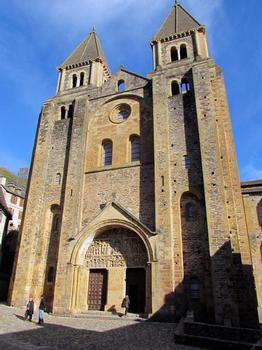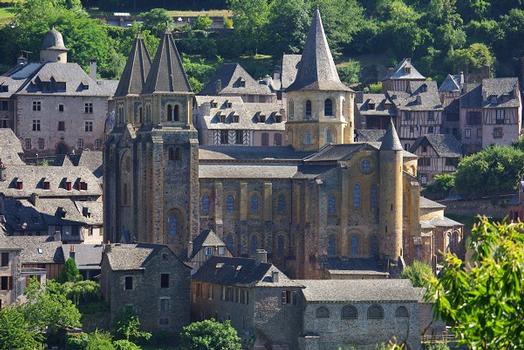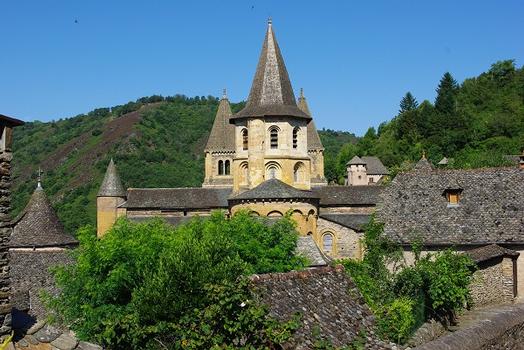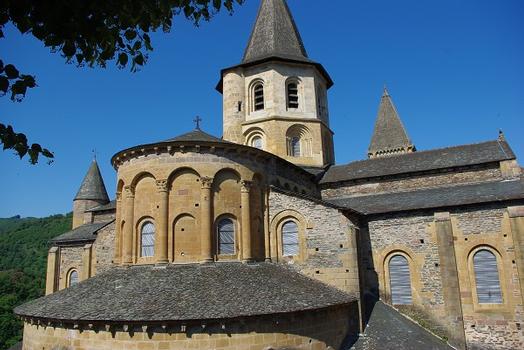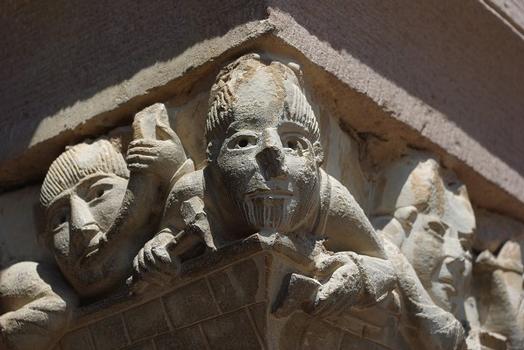General Information
Project Type
| Structure: |
Barrel vault |
|---|---|
| Function / usage: |
Church |
| Material: |
Masonry structure |
| Architectural style: |
Romanesque |
Awards and Distinctions
| 1998 |
part of an ensemble
for registered users |
|---|---|
| 1840 |
for registered users |
Location
| Location: |
Conques, Aveyron (12), Occitanie, France |
|---|---|
| Coordinates: | 44° 35' 57" N 2° 23' 53" E |
Technical Information
Dimensions
| exterior length | 56 m | |
| depth of radiating chapels | 3.60 m | |
| ambulatory | width | 3.80 m |
| nave | width | 6.80 m |
| length | 26.70 m | |
| height of nave vaulting | 22.10 m | |
| width of a side aisle | 3.80 m | |
| height of aisle vaulting | 10.50 m | |
| transept | width | 14.80 m |
| length | 34.80 m | |
| height of dome above transept | ca. 26 m |
Materials
| arches |
stone
|
|---|---|
| shell |
stone
|
| columns |
stone
|
| walls |
stone
|
Excerpt from Wikipedia
The Abbey Church of Saint Foy St. in Conques, France, was a popular stop for pilgrims traveling the Way of St. James to Santiago de Compostela, in what is now Spain. The main draw for medieval pilgrims at Conques were the remains of St. Foy, a young woman martyred during the fourth century. The relics of St. Foy arrived in Conques through theft in 866. After unsuccessful attempts to acquire the relics of St. Vincent of Saragossa and then the relics of St. Vincent Pompejac in Agen, the abbey authorities set their sights on the relics of St. Foy at the ancient St. Faith's Church, Sélestat. The Conques abbey opened a priory next to the shrine in Sélestat. A monk from Conques posed as a loyal monk in Agen for nearly a decade in order to get close enough to the relics to steal them.
Architecture
The original monastery building at Conques was an eighth-century oratory built by monks fleeing the Saracens in Spain. The original chapel was destroyed in the eleventh century in order to facilitate the creation of a much larger church as the arrival of the relics of St. Foy caused the pilgrimage route to shift from Agen to Conques. The second phase of construction, which was completed by the end of the 11th century, included the building of the five radiating chapels, the ambulatory with a lower roof, the choir without the gallery and the nave without the galleries. The third phase of construction, which was completed early in the twelfth-century, was inspired by the churches of Toulouse and Santiago de Compostela. Like most pilgrimage churches Conques is a basilica plan that has been modified into a cruciform plan. Galleries were added over the aisle and the roof was raised over the transept and choir to allow people to circulate at the gallery level. The western aisle was also added to allow for increased pilgrim traffic. The exterior length of the church is 59 meters. The interior length is 56 meters. the width of each transept is 4 meters. The height of the crossing tower is 26.40 meters tall.
The arches of the main aisle are simple rounded arches. These arches are echoed in the arches of the gallery which are half of the main arches' height with central supporting piers. Narrower versions of these arches are also found in the apse. The aisle around the apse is separated from the sanctuary by pillars and by the chapels which open up off of the transept. There are three radiating chapels off of the apse and two chapels off of the transept. The side aisles are roofed with a barrel vault that was originally covered with stucco. The nave at Conques is roofed with a continuous barrel vault which is 60 cm thick. The nave is divided into bays by piers which rise through the gallery and over the barrel vault. The piers of the naves are huge stone blocks laid horizontally and covered with either four half-columns or four pilasters. The interior of the church is 20.70 meters tall with the sense of verticality being intensified by the repeating pattern of half-columns and pilasters approaching the high altar. The barrel vault's outward thrust is met by the half barrels of the galleries which run the length of the nave and transept.
There are 212 columns in Conques with decorated capitals. The capitals are decorated with a variety of motifs including palm leaves, symbols, biblical monsters and scenes from the life of St. Foy. On the fifth capital of the north side of the nave are two intricate and expressive birds. On the corresponding capital on the south side of the nave are flat and lifeless human figures. The figures appear to have a slight hunch, as if they are reacting to the weight of the arches above them. The capitals functioned as didactic picture books for both monks and pilgrims. Traces of color are still visible on a number of the columns.
Light filters into Conques through the large windows under the groin vaults of the aisle and through the low windows under the half barrels of the galleries. The windows in the clerestory and the light from the ambulatory and radiating chapels focus directly onto the high altar. The nave receives direct light from the crossing tower.
The ambulatory allowed pilgrims to glimpse into the sanctuary space through a metal grill. The metal grill was created out of donated shackles from former prisoners who attributed their freedom to St. Foy. The chains also have a number of symbolic meanings including reminding pilgrims of the ability of St. Foy to free prisoners and the ability of monks to free the penitent from the chains of sin. The stories associated with the ability of St. Foy to free the faithful follows a specific pattern. Often a faithful pilgrim is captured and chained about the neck, they pray to St. Foy and are miraculously freed. The captor is sometimes tortured and then dismissed. The liberated pilgrims would then immediately travel to Conques and dedicate their former chains to St. Foy relaying their tale to all who would listen. As stories spread pilgrimage traffic increased.
There is little exterior ornamentation on Conques except necessary buttresses and cornices. The exception to this is the Last Judgment tympanum located above the western entrance. As pilgrimages became safer and more popular the focus on penance began to wane. Images of doom were used to remind pilgrims of the purpose of their pilgrimage. The tympanum appears to be later than the artwork in the nave. This is to be expected as construction on churches was usually begun in the east and completed in the west. The tympanum depicts Christ in Majesty presiding over the judgment of the souls of the deceased. The cross behind Christ indicates he is both Judge and Savior. Archangel Michael and a demon weigh the souls of the deceased on a scale. The righteous go to Christ's right while the dammed go to Christ's left where they are eaten by a Leviathan and excreted into Hell. The tortures of Hell are vividly depicted including poachers being roasted by the very rabbit they poached from the monastery. The tympanum also provides an example of cloister wit. A bishop who governed the area of Conques but was not well liked by the monks of Conques is depicted as being caught in one of the nets of Hell. The virtuous are depicted less colorfully. The Virgin Mary, St. Peter and the pilgrim St. James stand on Christ's left. Above their heads are scrolls depicting the names of the Virtues. Two gable shaped lintels act as the entrance into Heaven. In Heaven Abraham is shown holding close the souls of the righteous. A pudgy abbot leads a king, possibly Charlemagne, into heaven. St. Foy is shown on the lower left kneeling in prayer and being touched by the outstretched hand of God. Particularly interesting are carvings of the "curieux" (the curious ones), forerunners of the World War II-era cartoon image known as Kilroy, who peek over the edges of the tympanum. The tympanum was inspired by illuminated manuscripts and would have been fully colored, small traces of the color survive today.
Treasury
Conques is the home of many spectacular treasures. One of which is the famous 'A' of Charlemagne. The legend is that Charlemagne had twenty-four golden letters created to give to the monasteries in his kingdom. Conques received his 'A' indicating that it was his favorite. This is only legend; while the "A" exists it dates to circa 1100 and no other pieces of Charlemagne's alphabet have ever been found. Conques is also home to an arm of St. George the Dragon Slayer. It is claimed that the arm at Conques is the arm with which he actually slew the dragon.
The golden statue reliquary of St. Foy dominated the treasury of Conques. Catching a glimpse of the reliquary was the main goal of the pilgrims who came to Conques. The head of the reliquary contains a piece of skull which has been authenticated. The reliquary is a fifth-century Roman head, possibly the head on an emperor, mounted on a wooden core covered with gold plating. Made in the latter half of the ninth-century, the reliquary was 2 feet 9 inches tall. As miracles reportedly increased, the gold crown, earrings, gold throne, filigree work and cameos and jewels, mostly donations from pilgrims, were added. In the fourteenth-century a pair of crystal balls and their mounts were added to the throne. Silver arms and hands were added in the sixteenth century. In the eighteenth-century bronze shoes and bronze plates on the knees were added.
In the 19th century, the author and antiquary Prosper Mérimée, appointed the first Inspector of Historical Monuments, inspired thorough restorations.
The St. Foy abbey-church was added to the UNESCO World Heritage Sites in 1998, as part of the World Heritage Sites of the Routes of Santiago de Compostela in France. Its Romanesque architecture, albeit somewhat updated in places, is displayed in periodic self-guided tour opportunities, especially of the upper level, some of which occur at night with live music and appropriately-adjusted light levels.
Text imported from Wikipedia article "Abbey Church of Saint Foy" and modified on July 22, 2019 according to the CC-BY-SA 4.0 International license.
Participants
Currently there is no information available about persons or companies having participated in this project.
Relevant Web Sites
Relevant Publications
- (1972): Art & Architecture in Medieval France. Medieval Architecture, Sculpture, Stained Glass, Manuscripts, the Art of the Church Treasuries. Icon Editions (Harper & Row Publishers), New York (USA), pp. 30-36.
- (2003): Histoire visuelle des Monuments de France. Larousse, Paris (France), pp. 48-51.
- (2005): Qu'est-ce que l'architecture?. Une histoire de l'Architecture. Editions Gründ, Paris (France), pp. 261.
- (1990): Rouergue roman. Editions Zodiaque, Saint-Léger-Vauban (France), pp. 29-31, 91-247.
- About this
data sheet - Structure-ID
20002177 - Published on:
05/11/2001 - Last updated on:
11/06/2024

